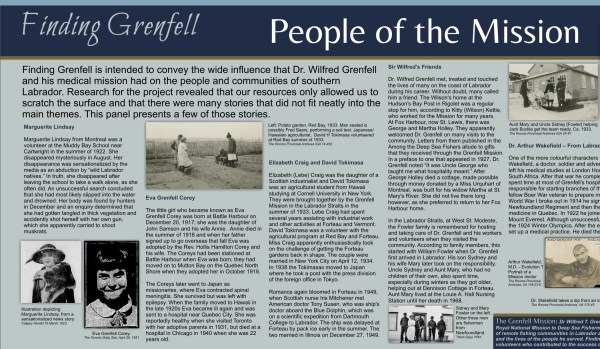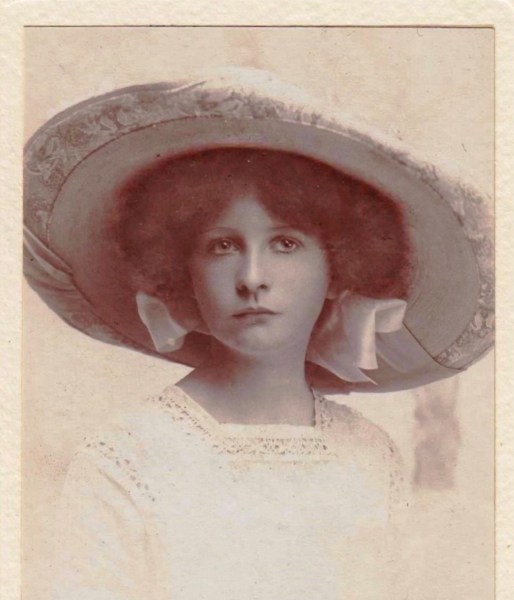Marguerite Lindsay wrote a letter from Cartwright, Labrador, to her brother in Montreal, Quebec. The letter was postmarked July 29, 1922. Six days later she was dead.
Marguerite, 26, volunteered as a summer teacher in 1922 with the Grenfell Mission1 at Rev. Henry Gordon’s orphanage school in Muddy Bay six miles from Cartwright. She ran the recreation program for Rev. Gordon and taught the older girls sports such as swimming and introduced the game of french cricket which the boys played as well.
In her long newsy letter to her brother, she mentioned the gunfire from the previous night which announced the arrival of the “Bayeskimo2” in Cartwright. It had taken the ship just a week to come from a very hot Montreal. She wrote: “It is really cold here and foggy quite often, but very bracing, and I like it much better than heat; also when it is cold, there are no flies, and that means a great deal.” Then she described the local bug problem with a delightful sense of humour:
“We bathe in citronella. About 50 of them were getting free transportation on different portions of my anatomy … and there is a species of black fly, and their teamwork with the mosquito is extraordinary. They don’t bother to pierce your epidermis for themselves but follow exactly in the footsteps of the mosquitoes, and they hurt. I could hardly turn my head for a day, the back of my neck was so bitten.”
Perhaps that explains the white hat with a neck flap she wore in the photo of the children and staff sitting on the steps of the school. In another effort to protect herself at night, she cleverly tacked up strips of cotton gauze in the screen-less windows.

Annette Stiles, the other summer volunteer and nutritionist for the school, became close friends with Marguerite. In her letter, Marguerite wrote: “We were bewailing our inadequacies about things we had to tackle; but Annette very truly remarked, that anything we could do was an improvement.” Between them, they cared for about 28 orphaned children3 and gratefully “the children’s enthusiasm was very contagious – a great contrast to the boredom of some in more civilized places.”4
These unfortunate children had multiple health issues as well – many of them suffering from tuberculosis and/or scurvy and berri-berri5 – mostly due to their poor diet. It appeared that the boys were much brighter than the girls and the adult ratio in the community was four men to every woman.
She continued her letter with a brief description of her daily routine: “We are teaching the children to swim; the water is not as cold as you might think…and you would be amused to see me giving the children drill, and getting them to breathe through their noses.”
The friendly duo happily shared their combined duties. “We really have been working awfully hard, but Annette is amusing to work with. We are cooking for some 30 odd people… and some of the experiments would turn your hair grey!”
Overall she adapted to the local food: “The salmon is in now, and we get over 100 a day in the net just off the point. It is very good; am also getting used to condensed milk.” She lamented the lack of ice, but mentioned that any attempts to capture young icebergs were foiled, as it proved too difficult to tow them home behind a boat without them breaking free.
As a reward for all their hard work, Rev. Gordon gave the two volunteers the day off, to accompany a fisherman and some boys on an expedition for firewood across Sandwich Bay. It took three hours to cover the 18 treacherous miles across the stormy waters. The “fisherfolk” at the point of White Bear River welcomed them warmly upon arrival and kindly provided food and a place to stay.

“We had expected to sleep on the floor, so had brought rugs; but Annette and I were given a bunk in a room about the size of a dugout, which was really comfortable after we had skilfully removed a pane of glass with a knife, the window being purely for ornament. They provided us a feather bed in the bunk, warm and dry rugs, and fed us with smoked salmon and cariboo meat. It was loads of fun.”
The next morning, they walked up White Bear River for a few hours…”as pretty a place as you could find” before safely returning to Muddy Bay later the same night with ”a perfect run right into the sunset”.
A few days before Marguerite mailed her letter, she met Dr. Grenfell himself (the head of the Mission) when the year’s supplies arrived by steamer. He made such an impression on her that she wrote – “he certainly has a great personality and has accomplished more than would seem possible.” Although Rev. Gordon and the men were away Marguerite told Dr. Grenfell: “Oh we can work just as well as men. You must treat us as such.” and the two girls insisted on rolling barrels and carrying boxes with the rest of the crew.
Soon after Marguerite’s death, Dr. Grenfell wrote a letter of condolence to her mother and spoke of “…the pleasure of meeting and knowing the joyous spirit of your daughter and the full measure of energy she was so gladly giving to help others.”
On August 4, 1922, six days after mailing her last letter home, Marguerite died accidentally while on a walk in the nearby woods.
For the whole story on Marguerite please read:
how i came to write miss lindsay’s tale
1https://www.findinggrenfell.ca/home/files/pg/panel-people-v4-large.jpg as referenced 2021-08-07.
2 Ship Bayeskimo – https://wiki2.org/en/Hudson%27s_Bay_Company_vessels as of 2021-07-15
3Most of the children were orphans due to the Spanish Flu Epidemic in the area
4Among The Deep Sea Fishers, The Cartwright Expert Cook by Annette Stiles, p. 127.
5Beriberi is a disease of the nervous system caused by a person not getting enough thiamine B(vitamin B1) in the diet







